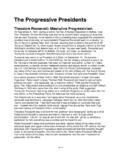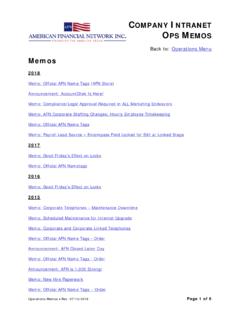Transcription of A Publication of the American Management Association for ...
1 THE PRESIDENTA Publication of the American Management Association for members of the Presidents Association The CEO s Role inStrategic PlanningBy A. Paul Bradley, Jr. What is my role in the strategic planningprocess? In my over ten years of speaking at seminarsand roundtables for CEOs, I have heard thisquestion countless times. It seems that allpresidents know they should lead the planningprocess, but few are clear about what this result is that for some CEOs and theirmanagement teams, the planning process is a poorand destructive rather than creative CEO, should you be the facilitator ofretreat sessions? Should you let the team planalone? Should you sit in but remain totally silentor, if not, when and on what topics should youspeak up? These are perplexing questions. Let meshare with you my personal point of view on theseissues based on my 20 years experience as aplanning participant, CEO, and consultant-facilitator of strategic planning are three phases to planning:preparation, the creative thinking process, andimplementation.
2 Each requires you to play adifferent preparation stage is the stage at whichyou, as CEO, are the most visible and proactive. Itinvolves:Determining the parameters. There must beclarity about what must be accomplished. CEOsmust first be clear in their own minds about thescope of the planning, or they cannot help the team. Effective planninginvolves virtually the entire company but at theplanning retreat itself, only so many can it is normal to take only the top managementteam, many companies now regularly invite one ortwo representatives of middle and even lower-levelmanagement to provide a different perspective orcontribute to discussions in their specialty on who will participate should bemade by you. While feelings of other teammembers are a consideration, planning deals withthe survival of the company so politics must take aback seat to a facilitator.
3 I do not wish to soundself-serving I lead planning sessions for a living but there is only one answer to the question ofwhether you should facilitate your own process: No! The collective wisdom of CEOs at theManagement Course for Presidents where thisquestion always arises is that CEOs should neverrun the meetings, even if they have years ofexperience in planning. By definition, thefacilitator cannot fully participate in the meeting;he or she needs to worry about flow, the psychicstate of participants, energy levels, and the like. AsCEO, you should be concentrating on facilitator should be someone in whomyou have complete confidence. While your teammay make suggestions, the final decision is the climate. Virtually everyone in thecompany needs to know that planning is takingplace and should care. To build involvement, senda memorandum requesting even requiring ideason some element of the planning.
4 This willpromote involvement and, ultimately, commitmentto memorandum should also reflectenthusiasm and optimism. Your planning retreatwill be contributing to the creation of yourcompany s future. That is exciting, so say return from the retreat, do somethingsimilar to maintain interest and Creative ProcessThe actual retreat is a time for you to be lessvisible, less active. However, as CEO, you don tjust sit back and the session. You should begin thesession by reiterating the overall guidelines,personal commitment, and faith in the team. Alsoshare with the group your personal confidence inthe to be quiet. The deliberations arethe toughest time for many presidents. They havemade a major investment in the process and nowhave an opportunity to learn their team's ideas. Buttoo many talk instead. Your role during the sessionis to listen while silently asking two questions: (1) Is this where we want to go?
5 And (2) Are thesethe people who will get us there? Ask thesequestions over and over. During the planning, youwill see your people in a different light than thatcast by day-to-day activities. Some will reflectbrilliantly while others will almost disappear. Theplanning process is a wonderful team building andteam assessment laboratory but only for the CEOwho properly uses it. At times, the facilitator mayexperience a log jam and ask the CEO to decidehow the group should proceed. That is OK. Therewill also be times when you may want to introduceideas. That s fine, too. But a more productive roleis to ask questions and make sure that peopleanswer with data. In short, be judicious with yourcomments and opinions but not totally the meeting. I don t recommend thisapproach but the most powerful ending to aplanning session I ever saw happened when, justbefore adjournment, the CEO asked the managers,one by one, whether they were committed to theobjectives of the five-year plan and to the variousbenchmarks.
6 Armed with affirmative replies, theCEO then asked, What should I do if we are offtarget a year from now? What s fair? The tensionin the room was enormous while the CEO, again,went to each I recommend this approach only toCEOs skilled in CPR, I never saw a team socompletely recognize the seriousness of theprocess. All realized that they had truly bet theirjobs on the team s future of your company is at stake. AsCEO, you should close the meeting in a mannerthat reflects this reality to all , it is best to create enthusiasm, not the plan is in place, the role of the CEOagain changes to:Overseer of discipline. Companies thatmonitor action plans effectively succeed atplanning. Companies that simply go on retreatsfail. My experience shows that these are almostabsolute truisms. Plans fail because of inattentionto follow CEO, you should regularly ask about teamperformance on action plans.
7 In addition, to helpwith course correction, have the facilitator visitperiodically for action plan review meetings. Oneservice The Bradley Group, Inc. provides ismonthly ticklers to those responsible for has greatly improved success depends on regular inspection ofwhat you When the CEO doesn t carry outhis or her own assignments tied to the strategicplan, a message is sent to the entire organizationthat makes it difficult to demand performance fromothers. Without exception, when I work withteams whose CEO completes all assignmentsthoroughly and well, everyone does and the plansucceeds. Not so, the reverse. CEO actions are thebest indicator of interest. However, more proponent. In the introduction toGeorge Steiner s classic book Strategic Planning:What Every Manager Must Know, the authordescribed research on 300 companies that hadfailed in planning efforts.
8 The universalcharacteristic was lack of CEO visibility andinvolvement. This article has suggested severalareas to achieve both, but there is one more CEOrole in strategic planning: cheerleader. Recognizesuccess, and give credit freely and often. You willappreciate the sense of satisfaction that comes frombeing the leader of a team effort that brings successin which all can take personal Paul Bradley, Jr. is president of The BradleyGroup Inc., a Saratoga Springs, New York-basedconsulting firm offering help in strategic planningto companies of all sizes. Bradley is a speaker forThe Presidents Association of AMA. A. Paul Bradley, Jr.







